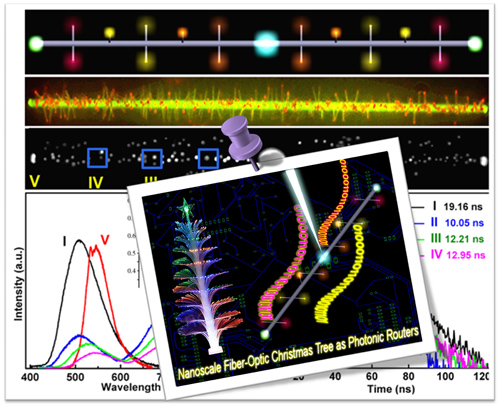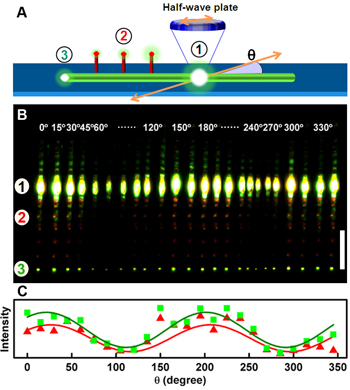Nanophotonics mainly studies how to manipulate, adjust and control the movement of photons on the micro-nano scale, and has broad application prospects in future signal propagation and information processing. Researchers from the Key Laboratory of Photochemistry at the Institute of Chemistry of the Chinese Academy of Sciences have conducted systematic studies in low-dimensional organic materials photonics in recent years. In the previous research on one-dimensional organic optical waveguide materials (Adv. Mater., 2008, 20, 1661-1665; Angew. Chem. Int. Ed., 2008, 47, 7301-7305), researchers discovered organic materials The mechanism of exciton polarization excitons (EP) in organic photonics formed by the strong coupling of Frenkel excitons and photons in the process; and then using triplet sensitization, through the bidirectional energy transfer in the process of EP propagation, An optical waveguide device that achieves stable white light output (Adv. Mater., 2011, 23, 1380-1384); further utilizing the ultra-high refractive index of exciton polarization excitons in organic crystal materials to realize two-photon pumped organic Nanowire laser (J. Am. Chem. Soc., 2011, 133, 7276-7279). Related work has confirmed the great potential of organic low-dimensional materials in nanophotonics, laying a foundation for the realization of photonics functional elements based on low-dimensional organic materials. Recently, with the support of the National Natural Science Foundation of China, the Ministry of Science and Technology, and the Chinese Academy of Sciences, researchers have collaborated with Professor Huang Jiaxing of Northwestern University in the United States. Using the specific assembly and growth characteristics of small organic molecules, the two-step method of liquid phase and gas phase realizes the controlled epitaxial growth of the guest molecule DAAQ on the one-dimensional backbone structure of the host molecule Alq3, resulting in a one-dimensional organic branch Heterostructure. Combining the fluorescence resonance energy transfer (FRET) in the organic heterostructure and the properties of the optical waveguide, a nano-photonic router with signal modulation can be realized. These research results provide important insights into the in-depth study of the assembly behavior of organic functional molecular systems, the control of the synthesis of functional organic complex micro-nano structures, the study of the inherent mechanism of photonics in complex structures, and the exploration of various components needed in photonic communication and operations For reference. Related results were published in the recent "Journal of the American Chemical Society" (J. Am. Chem. Soc., 2012, 134, 2880-2883). The British Society of Chemistry's Chemistry World magazine reported on this work with the title of Branched organic nanowire heterojunctions. Figure 1 Low-dimensional organic nanophotonic router, which can realize single point excitation and multi-channel different optical signal output Figure 2 The modulation effect of different polarization input on the output signal of each terminal of the organic nanophotonic router The children's study table and chair set is furniture for children aged 3-18 to learn to write homework. The table has a lot of storage space. The table board is made of solid wood core material. The table board can be adjusted and the table legs can be raised and lowered to meet various requirements. Children of height can do homework and draw pictures; the table can be used from kindergarten to university. Fashionable color schemes make children love to learn more. Because of the large storage space, children can also cultivate good storage ability. Study Desk,Adjustable Height Study Desk,Modern Kids Study Desk,Ergonomic Children Furniture Sets Igrow Technology Co.,LTD , https://www.aigrowdesks.com


The Institute of Chemistry has made important progress in the cooperative research of low-dimensional organic photonics components